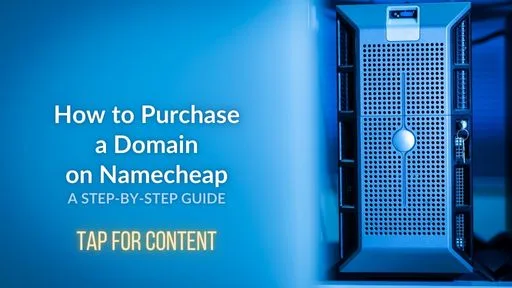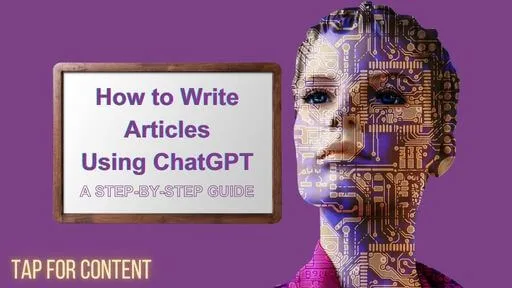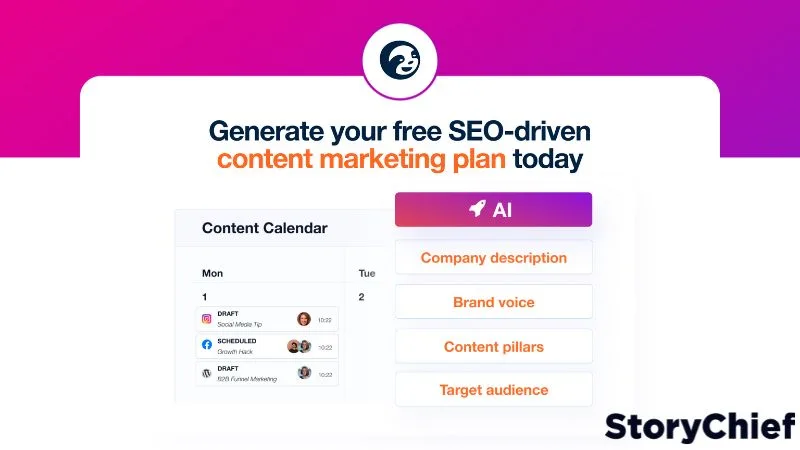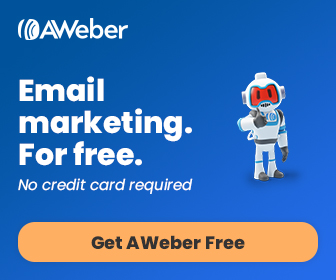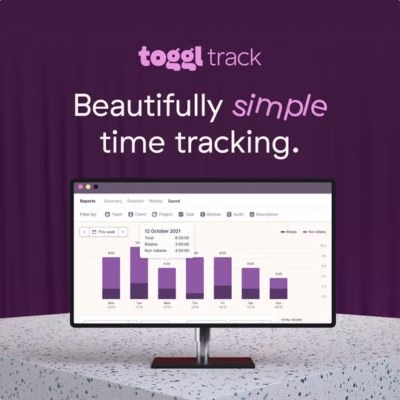Last updated on January 19th, 2025 at 01:29 pm
Can you make money while you sleep, or is that just a dream? Though it sounds too good to be true, affiliate marketing fulfills that promise if the job’s done well. You earn by generating sales for companies you partner with, and you don’t need to be awake when the customer clicks!
There’s a lot of work to do before you put your laptop away and slumber, though, which is why I’ve put together this step-by-step beginner’s guide on how affiliate marketing works. It includes the tools and resources you’ll need to make the magic happen and almost everything you need to know about affiliate marketing, so don’t go to bed yet!
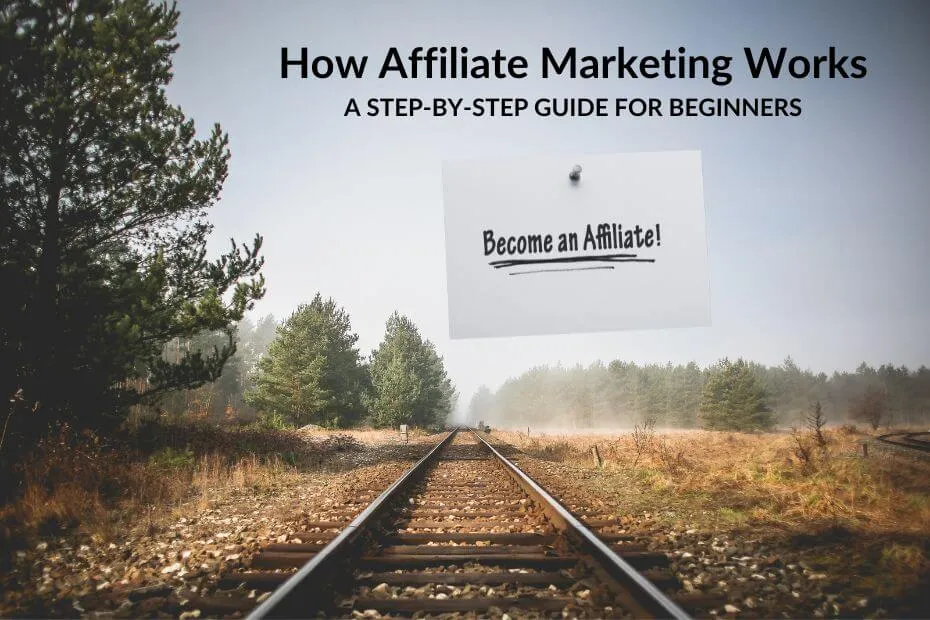
Step 1: Understand What Affiliate Marketing Means
Whether you’re longing for financial freedom or looking for ways to supplement your income, affiliate marketing may be just what you need. Before you get your hands dirty, though, knowing some affiliate marketing basics is important.
What is Affiliate Marketing?
What is affiliate marketing, exactly? The UK’s Advertising Standards Authority (ASA) defines it as “a type of performance-based marketing where an affiliate is rewarded by a business for each new customer attracted by their marketing efforts.”
You’ll be driving people from your website or social media channels to another company’s website to buy a product or service or at least become a potential customer for that business. This leads us nicely to how affiliate marketers get paid:
How Affiliate Marketers Earn Money
The most common remuneration is receiving a percentage of sales when someone buys a product after following your links. You can also be paid for generating “leads” for a company, which are traceable when potential customers complete a specific action (e.g., registration, subscription, or form submission) at your direction. Other earning methods include getting customers to download and install software, such as a mobile app, or use a coupon code you provide.
The Key Players in Affiliate Marketing
At its core, affiliate marketing involves three key players: affiliates, merchants, and consumers. Each plays a vital role in the ecosystem, and understanding their interplay is an excellent place to start:
- Affiliates are marketers who promote products to potential buyers. They can be bloggers, influencers, content creators, or anyone with an online presence seeking to monetize their audience. It’s people like you and I, so you should know we are also called “publishers” in some contexts.
- Merchants, or advertisers, are businesses that sell products or services. They partner with affiliates to expand their reach and drive sales. Their success hinges on the affiliates’ ability to generate leads and convert them into customers.
- Consumers are the end-users who purchase the products or services through affiliate links. They often rely on affiliates’ recommendations and content to make informed buying decisions.
Why Affiliate Marketing Remains Popular
What makes this model appealing is its low-risk, high-reward nature. You don’t need to manage inventory, handle customer service, or process returns. Your primary focus is promoting the products effectively, and your financial outlays are minimal and largely controllable.
Using affiliate marketers is beneficial to businesses because it is essentially free advertising. Businesses only pay when an affiliate generates sales or leads, which enhances their brand’s exposure.
Consumers are also benefactors of the affiliate marketing triarchy because content creators usually provide first-hand product reviews that are genuine, do the market research for them, and provide the information they need before making a purchase.
The affiliate marketing statistics summarized by demandsage.com are eye-popping. For example, the industry is expected to reach a market size of $48 billion by 2027, and 80% of brands now have an affiliate marketing program. There are bountiful opportunities for aspiring marketers and room for more fish in an ever-expanding pond.
The Affiliate Marketing Model
To truly understand what affiliate marketing means, you should embed the principles in your mind and make everything you do an aid to the process. The infographic below shows how affiliate marketing works from a marketer’s perspective, and I’m sure you’ll be relieved by its simplicity:
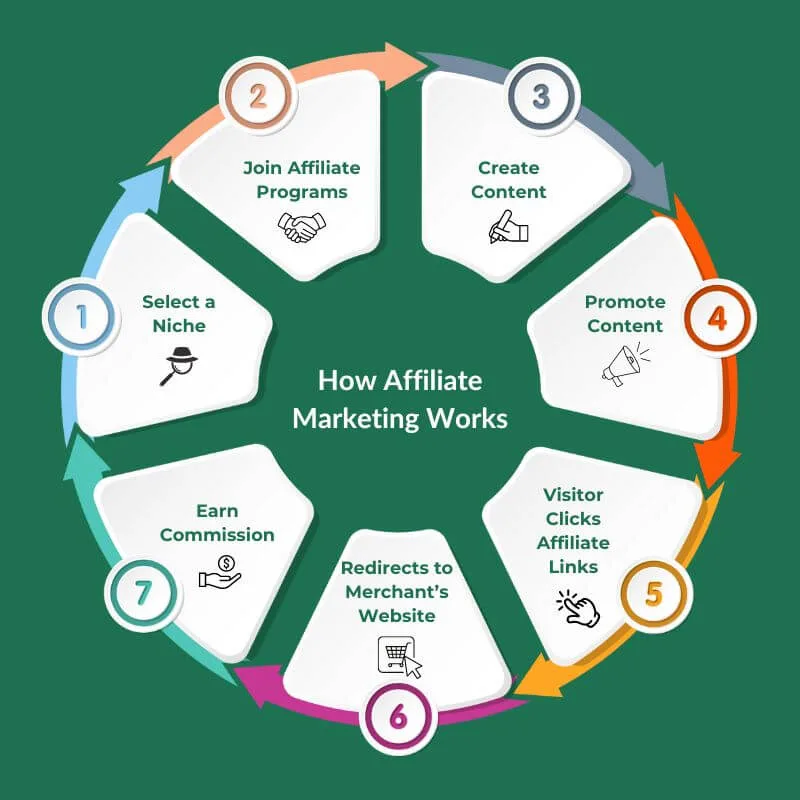
Set Realistic Expectations: While affiliate marketing can be incredibly rewarding, it’s important to set realistic expectations from the start. Success doesn’t happen overnight. Focus on building trust with your audience and providing value through your content. Remember, consistency and patience are key to long-term success.
Please note that the remainder of this post contains some affiliate links. Read our affiliate disclosure for full details.
Step 2: Choose a Niche
Your niche is the specific area or topic you’ll focus on, influencing the type of content you create and the products you promote. Of course, picking a niche for your affiliate marketing efforts is a tall order and one you can spend an excruciating amount of time trying to decide on.
Getting it right the first time would be fantastic but, perhaps reassuringly, would put you in a small percentage of affiliate marketers who are still in the same niche they started with as beginners. You’d be wise to consider this your “first niche” rather than committing your entire affiliate marketing career to a speculative hunch. It is important, though.
Why Choosing a Niche Matters
A niche helps you attract a targeted audience, allowing you to build trust and authority. When you speak directly to the needs and interests of a specific group, your content becomes more relevant, engaging, and likely to convert.

How to Choose a Niche
- Identify Your Interests: List topics you’re passionate about or knowledgeable about. This will make it easier to create content and keep you motivated in the long run.
- Research Market Demand: Use tools like Google Trends and keyword research to determine the popularity of your potential niche. Make sure there’s steady or growing interest in the topic.
- Analyze the Competition: Some competition is good, and too much is terrible. Look for niches where you can find a balance and gaps in existing content.
- Evaluate Affiliate Potential: Check to make sure there are affiliate programs in your niche. Consider the products, commission rates, and overall earning potential.
- Test Your Niche: Before fully committing, test your niche by creating content and seeing how the audience responds. Be prepared to adjust if needed.
Don’t Overthink Your First Niche: Your first niche can be imperfect, and it’s okay to pivot if needed. Many successful affiliate marketers started in one niche and transitioned to another as they learned more about their audience and what works best. The most important thing is to begin—refinement can come later!
Step 3: Find Affiliate Programs to Join
Knowing what affiliate programs to join and how to find them can be a headache, but it is easy once you get savvy with your research. The most important principle is to find affiliate programs that align with your chosen niche.
Although there are various models, the most common types of affiliate programs are pay-per-sale (earning a commission when someone buys a product), pay-per-lead (getting paid for generating leads), and pay-per-click (earning a small fee for each click on your affiliate link). Each has pros and cons, but your choice will often depend on your niche, and you’ll naturally gravitate toward specific programs as you gain experience.
As a beginner, you must be patient while networks or companies assess your website’s suitability for the program. This often requires your website to have sufficient content, relevancy, and traffic, so you’ll revisit this step once you’ve gathered an audience and written more articles. However, Amazon Associates and eBay Partner Network give you easy access to many products you can sell immediately if you want a quick start.
Choosing the Right Affiliate Program
However you start, ensure that the program is relevant to your niche. The more closely the products or services align with your audience’s interests, the higher your chances of converting clicks into sales. Researching the reputation of the brand and its affiliate program is also recommended. Look for programs with a track record of reliable payments and good support.
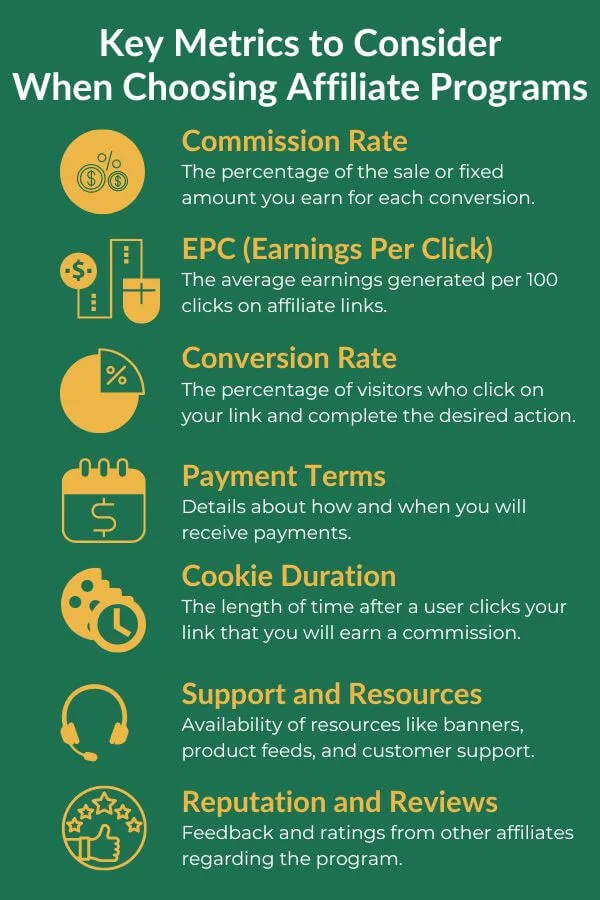
The commission structure will obviously be a draw but don’t make it your only consideration. While high commission rates are attractive, they often come with higher-priced products that may have lower conversion rates. It’s more important that a product fits your niche and appeals to your audience. Lower commissions on popular products might lead to higher earnings because you sell more!
Where and How to Find Affiliate Programs
Finding affiliate programs to join involves research and exploration, but signing up for affiliate networks like ShareASale and CJ Affiliate is a great starting point. They coordinate affiliate programs across multiple niches, making it easy to find products/services that align with your content. They also provide tools to track your performance.
Get signed up for these at the earliest opportunity:
- ShareASale: A user-friendly platform ideal for beginners and with an extensive range of merchants in the small to mid-sized business category.
- CJ Affiliate (formerly Commission Junction): Best known for its high-quality merchant partnerships, including many Fortune 500 companies.
- ClickBank: Best for digital products, including eBooks, software, and online courses.
- Impact (formerly Impact Radius): Popular among affiliates working with big brands in the retail, finance, and travel industries.
- Rakuten Advertising (formerly Rakuten Marketing): Best known for its premium brand partnerships, especially in the fashion, luxury, and electronics sectors.
- Awin (formerly Affiliate Window): Particularly popular in the fashion, travel, and finance sectors.
Beyond networks, many companies offer direct affiliate programs. These can provide better terms, such as higher commissions or exclusive promotional opportunities. To find these programs, identify brands within your niche and visit their websites. Often, companies list their affiliate programs in the footer section or under headings like “Affiliate” or “Partner Program.” Search queries like “[Brand] affiliate program” can also help uncover these opportunities.
Affiliate program directories such as AffiliateProgramDB.com and AffiliatePrograms.com offer listings of various programs sorted by category, making it easier to find programs that suit your niche.
Explore and Experiment: Starting with a few different programs can help you discover what works best for your niche and audience. Feel free to experiment with various products and networks to see which ones resonate most with your readers. Over time, you’ll refine your approach and find the programs that consistently perform best for you.
Step 4: Build an Online Presence
You need an online presence to start an affiliate marketing enterprise, beginning with a website. It will be your online platform, where you will create content, engage with your audience, and drive traffic to your affiliate links. While websites are crucial, you mustn’t forget social media—being present online means reaching a broad audience, so websites and social go hand in hand.
Here’s how to get these first steps right:
Get a Domain Name and Hosting
The first things you need are a domain name and hosting for your website. A good domain name is memorable, relevant to your niche, helps establish your brand, and makes it easy for your audience to find you. Your hosting provider must be fast, reliable, secure, and able to support your CMS (Content Management System) of choice.
Ten Steps Away recommends WordPress as your website builder because it’s an open-source platform, a market leader, and a CMS that most hosts can install for you. It’s also very customizable and well-supported.
Domain Name
Choosing the right domain name is essential as it will often be your brand name as well. It should be short, easy to spell, and relevant to your niche. If you’re struggling for ideas, NameMesh allows you to enter keywords or ideas related to your niche and then generates domain name suggestions across several categories, such as common, new, short, fun, and SEO-friendly. It also shows you their availability.
When you’re ready to purchase, use a service like Namecheap, which is as the name implies. You can search for available domain names and buy the one that fits your brand. Namecheap has competitive pricing and excellent customer service, which is perfect for beginners. You can point the name to your host’s servers or use Namecheap’s own.
Avoid Domain Name Clangers: When choosing a domain name, be careful not to miss any unintended double meanings or confusing combinations of words. For instance, a domain like “catscantalk.com” might seem perfect for a feline blog, but it can also be read as “CAT Scan Talk,” which could send your audience (and search engines) in a totally different direction! Avoiding these pitfalls will save you from potential branding headaches and ensure your domain name is as straightforward as possible.
Web Hosting
Once you have a domain name, you’ll need a hosting service to get your website up and running. Bluehost is a popular choice, especially for WordPress users. They offer one-click WordPress installation, 24/7 support, and affordable plans for new websites. With Bluehost, you can be sure your website is fast, secure, and always available.
Secure Your Social Media Usernames
After securing your domain, the next step is to ensure that your brand is consistent across all platforms. Before finalizing your domain name, check its availability as a username on major social media platforms. Consistency in branding helps build trust and makes it easier for your audience to find and follow you across different channels. Use tools like Namechk to see if your desired username is available on platforms like Instagram, Twitter (now X), Facebook, and Pinterest.
Set Up Your Social Media Accounts
With your domain name and usernames secured, it’s time to set up your social media profiles. Even if you plan to focus primarily on one platform, reserving your brand name on all major social networks is beneficial. This way, you can expand your presence in the future without worrying about name availability.
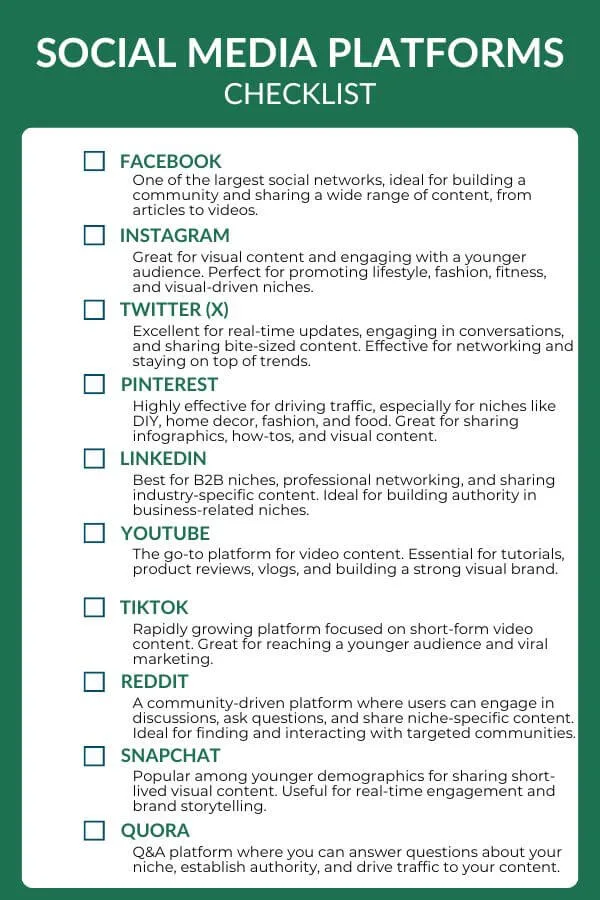
When setting up your profiles, ensure they reflect your brand’s identity. Use a consistent logo, color scheme, and bio across all platforms. While setting up business accounts, look for opportunities to link back to your website, whether through your bio, posts, or stories.
Create an “About” Page on Your Website
Your “About” page is an essential part of your website. It tells your audience who you are, what your brand stands for, and why they should trust your recommendations. Share your story, your experience in the niche, and your mission. This personal touch helps build credibility and forms a connection with your visitors.
Engage in Niche Forums and Communities
Building an online presence isn’t just about your website and social media. Engaging in niche-specific forums and communities is a powerful way to establish authority and drive early traffic to your site. Find active forums or groups related to your niche on platforms like Reddit, Quora, or niche-specific websites.
You can build relationships with others in your niche by participating in discussions, answering questions, and sharing valuable insights. These connections can lead to backlinks, collaborations, and an initial flow of visitors to your website. Just remember to add value and avoid spamming your links—focus on building genuine relationships first.
Consistency is Key: Whether you’re posting content on your website or engaging on social media, consistency is critical. Regularly updating your platforms and staying active in your niche community helps build trust and keeps your audience engaged. Plan your content ahead of time to maintain a steady presence and make it easier to stay on track.
Step 5: Create High-Quality Content
Creating high-quality content is crucial for attracting and retaining your audience and driving conversions through your affiliate links. Here’s how to get started with creating content that resonates with your readers:
The Importance of Quality Content
High-quality content builds trust, authority, and engagement with your audience. Whether you’re writing blog posts, creating videos, or developing other types of content, the key is to provide value that meets your audience’s needs.
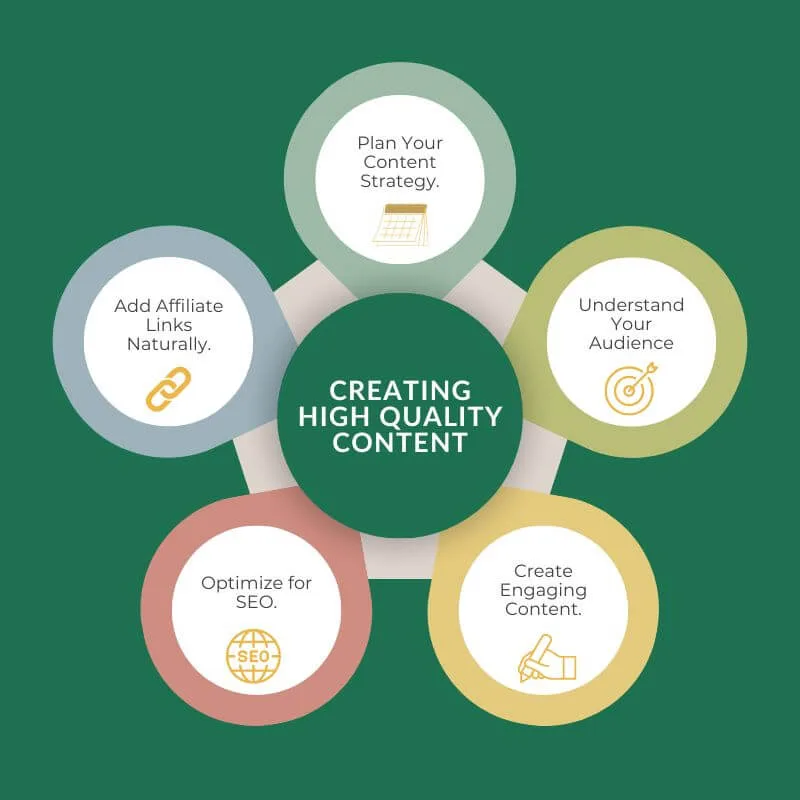
So, what makes content high-quality? That’s a detailed study in itself, but here are some pointers:
- Relevance: Quality content is always relevant to the needs and desires of its target audience. The buzz you feel when you address pain points, answer questions, and provide solutions is a tick against this box.
- Accuracy and Depth: Your content should be well-researched, up-to-date, and fact-checked. Reference your sources and ensure they have the same level of integrity as you.
- Engagement: Structure your articles so they’re easy to read and navigate. Headings, bullet points, and visuals will help break up the text.
- Originality: This article would have been a lot quicker to write if it was a regurgitation of similar posts online. My tip is to always include a “what’s new or unique” note in your article planning phase. In this post, for example, I’ve broken affiliate marketing down into ten steps and designed infographics to support your journey. And if you’re not amused by my occasional humor, well, at least it’s mine. Remember to be yourself when writing!
- Value-Driven: You want your readers to get something out of the post they’re reading. They haven’t come to your site for their love of words if they searched for “how to get cat hairs off my dinner jacket.” Practical content that helps readers solve problems or achieve goals is more valued.
- SEO Optimization: Integrating keywords like “how to get cat hairs off my dinner jacket” will allow search engines to match your post with the right audience when they’re browsing. This means you’re more likely to satisfy your visitors’ search intent, which builds trust and appreciation.
- Readability: Ensure that your content is polished and professional by using tools like Grammarly or Hemingway to check for spelling, readability, and grammar.
Planning Your Content Strategy
Start by planning your content with a focus on consistency. A content calendar can help you stay organized and ensure that you’re regularly publishing new material. Consider using a mix of pillar posts and cluster posts. Pillar posts are comprehensive guides on broad topics, while cluster posts dive deeper into specific subtopics. This approach organizes your content and helps boost your SEO through internal linking.
- Content Calendar Tools: Trello’s simple, visual approach can help you map out your content strategy, track deadlines, and ensure a steady flow of content. As a beginner, though, you may prefer more simplistic planning software such as Google Calendar, while I recommend StoryChief once you’ve established yourself. In honesty, an old-fashioned diary will be sufficient early on.
- Pillar and Cluster Posts: Identify broad topics within your niche that can serve as pillars. Write in-depth articles on these topics, then create supporting cluster posts that explore related subtopics in detail. This article, for example, is a pillar post, and you can see the countless opportunities for future articles. They’ll appear over time, so bookmark this page or subscribe to stay updated as these clusters develop.
Incorporating Affiliate Links: Place your affiliate links where they naturally fit within your content. Use clear call-to-actions (CTAs) to guide your readers towards clicking on these links, ensuring they add value rather than disrupt the reader’s experience. I’ve placed relevant banners and links within each step of this article so you can find them easily after reading or on your next visit.
Step 6: Drive Traffic to Your Content
To get more opportunities to earn commissions, you’ll need more eyes on your content, so understanding how to drive traffic to your website is essential. You can genuinely succeed as an affiliate marketer if you learn to master some or all of these techniques:
SEO (Search Engine Optimization)
Search Engine Optimization (SEO) is one of the best ways to increase “organic traffic” to your content. Organic traffic is freely obtained visits to your website, and by optimizing your content for search engines, your website will rank higher and reach your target audience.
Most WordPress users will install an SEO plugin on their website, and my favorite is RankMath, as it’s easy to use and has many indispensable features (as do AIO SEO, Yoast, SEOPress, and other popular options). Beginners will find the “freemium” versions meet all their needs and will only need one of them. They’ll help you learn, understand, and implement the basics of SEO:
- Keyword research is finding the words and phrases your target audience searches for online (you want to identify those with good search volume and low competition). Ahrefs, Semrush, and Google Keyword Planner are among the best keyword research tools, but you could also use AI (see the graphic below) or Answer The Public to get the job done quickly.
- On-page optimization means enhancing your posts so they will rank higher on search engine results pages (usually abbreviated to SERPs). Using keywords in strategic places like titles and headers and ensuring your site is easy to navigate are great examples of on-page optimization. You can use the RankMath plugin to evaluate your on-page SEO.
- Technical SEO includes site speed, mobile friendliness, and creating an XML sitemap that helps search engines understand your site’s structure. Google Search Console, Google Pagespeed, GTmetrix, Ahrefs, and Screaming Frog are incredible tools for spotting weaknesses and troubleshooting.
- Link building is getting other sites to link to your content. These are called backlinks, and search engines see them as votes of confidence, especially if the referring sites have authority. They prove your content is trustworthy, valuable, and worthy of ranking higher. Use Ahrefs’ Backlink Checker to check your and your competitors’ sites. Then, develop a link-building strategy from there (guest posting and contacting influencers or other sites are excellent ways to start). Try to steal a march on your competition by having linkable content tailored for reputable websites.
I recommend that beginners set up starter accounts with Ahrefs and Semrush at no cost. They might seem overwhelming at first, but they will immediately show you any major issues with your site. Also, check your site with Screaming Frog regularly to catch any SEO mistakes or opportunities you missed.
The importance of SEO can’t be understated, but it is prone to mystery and unexpected developments. It’s a good habit to stay up to speed on SEO by following online gurus, but don’t lose sight of serving your audience first and foremost.
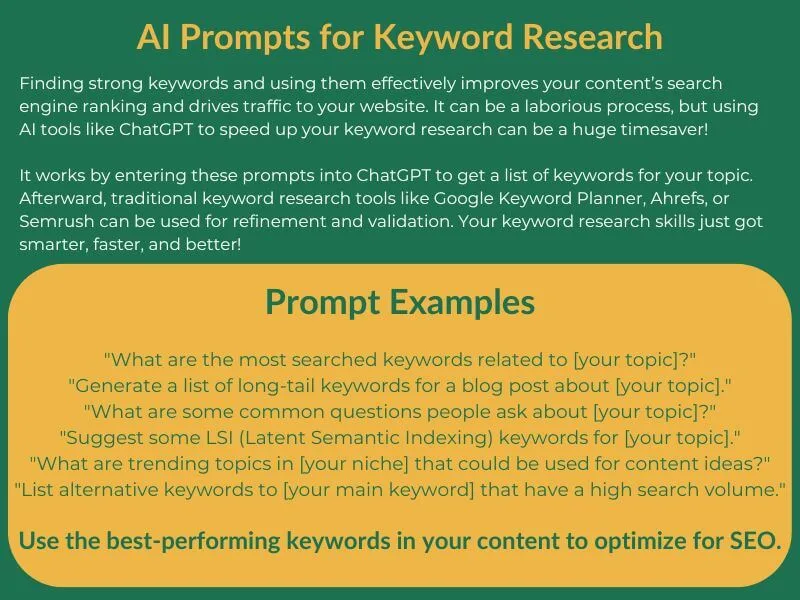
Social Media Marketing
Social media is an equally good way to drive traffic to your content. Platforms like Instagram, Facebook, X (Twitter), and Pinterest allow you to reach a bigger audience and talk to your followers directly.
- Platform Selection: Choose the platforms that fit your niche and audience. For example, Pinterest and Instagram are excellent choices for visual content, while X (Twitter) is great for quick updates and links. You’re more likely to reach the older generation on Facebook and a young demographic on TikTok, so hang out where your target audience is most active.
- Sharing Content: Share your blog posts, videos, and other content on social media using images, captions, and hashtags to get noticed. Tools like Hootsuite or Buffer can help you schedule posts across multiple platforms.
- Engagement: Building relationships on social media increases trust and drives more traffic to your website, so interact with your followers by responding to comments, joining relevant groups, and running polls or Q&As.
- Paid Social Ads: Run paid ads on social media to target specific demographics. Ads Manager is your starting point for running ads on Facebook, Instagram, and other Meta services, and these are popular with marketers.
Email Marketing
Email marketing is the most direct and effective way to drive repeat traffic to your content so long as your messaging is consistent and not spammy. By building an email list, you have a dedicated audience that will engage with your content.
- List Building: Offer a lead magnet, like a free eBook, checklist, or exclusive content, to get visitors to sign up for your list. Use platforms like AWeber to manage your list and automate campaigns (consider ActiveCampaign if you’re an advanced marketer).
- Newsletters: Sending regular newsletters to your followers with links to your latest posts, exclusive tips, and affiliate offers can increase engagement (and conversions).
- Email Segmentation: Segment your list based on interests or behavior to send content to different parts of your audience.
- Automation: Use automation to send welcome emails, drip campaigns, or abandoned cart reminders. This keeps your audience engaged without requiring constant manual effort.
Paid Advertising
Paid advertising can be a great way to drive targeted traffic to your content, especially when you’re just starting out and need to boost your visibility. Tread carefully, though, as paid advertising doesn’t guarantee a profit, and you’ll need to manage your spending.
- Pay-Per-Click (PPC): Use PPC ads to appear at the top of search results for specific keywords. Google Ads and Microsoft Advertising are popular options.
- Social Media Ads: Run ads on Facebook, Instagram, or Pinterest to target specific demographics, interests, and behavior. Start with a small budget and scale up based on results.
- Retargeting: Use retargeted ads to reach visitors who have interacted with your content but didn’t convert. AdRoll and Meta Pixel can help you set up retargeting campaigns.
Content Repurposing: To maximize the value of your original work, repurpose your content by sharing it in different formats, like videos, infographics, or podcasts. Turn blog posts into YouTube videos, webinars, or Instagram stories, and convert salient points from your articles into infographics that can be shared on social media or embedded in your posts.
Step 7: Promote Affiliate Products Effectively
You can drive all the traffic you want to your website, but you’ll struggle to make your mark as an affiliate marketer if you don’t know how to promote products effectively. Luckily, there are some tried and tested content types that will make this easier to get right. Let’s look at these and some of the dos and don’ts of content marketing:
Product Reviews and Comparisons
Writing in-depth product reviews or comparisons is one of the best ways to introduce affiliate products to your audience. Share your genuine thoughts, highlight the benefits and features, and provide personal experiences where possible. A well-written review helps build trust and positions you as a reliable source.
- Don’t just regurgitate product descriptions from the merchant’s website. Make your reviews unique by adding personal insights, pros and cons, and specific examples. Readers may lose trust in your recommendations if your review reads like a generic sales pitch.
- Do use design tools like Canva and Venngage to create professional visuals that make your reviews more appealing. Charts and product images make reviews more engaging and easier to understand.
Tutorials and How-To Guides
Show, don’t just tell. Tutorials and how-to guides are fantastic ways to demonstrate a product’s value by showing how it can solve a specific problem. This type of content is highly actionable and provides immediate value to your readers.
- Don’t be vague or generic in your instructions. Detailed, step-by-step guidance is more effective than glossing over the process. If your audience can’t easily follow the instructions, they won’t see the value in the product.
- Do record step-by-step videos using tools like Loom to walk your audience through using the product, or include screenshots and step-by-step instructions to make your guide easy to follow.
Banner Ads and CTAs
Banner ads and call-to-action (CTA) buttons can effectively direct readers to the products you’re promoting, but they need to be used wisely.
- Don’t overwhelm your readers with CTAs and banners. They can become intrusive and disruptive if you place too many and might drive people away from your site.
- Do experiment with different placements and designs for your CTAs. Use tools like Microsoft Clarity to test what works best for your audience.
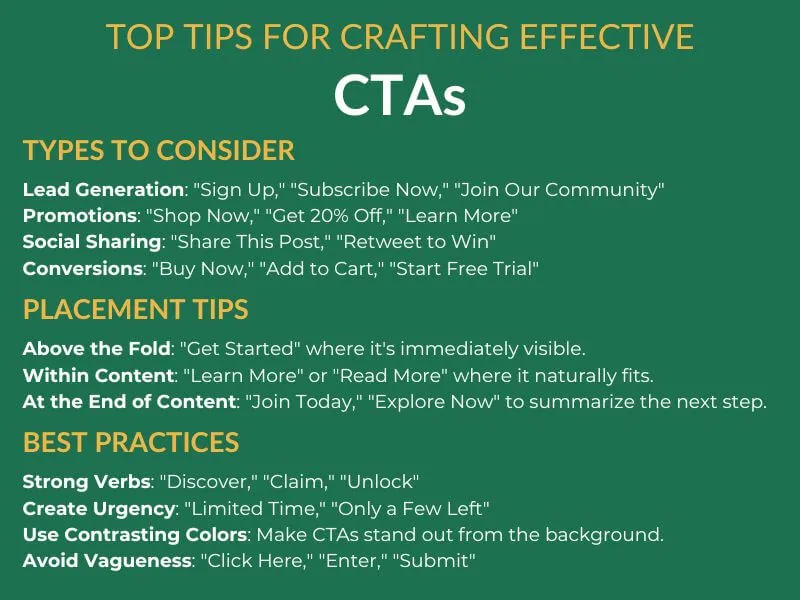
Social Proof and Testimonials
Incorporate social proof, such as customer testimonials or case studies, to reinforce the product’s value. When readers see that others have benefited from a product, they are more likely to trust it.
- Don’t use fake or overly optimistic testimonials; they can backfire and damage your credibility.
- Do use platforms like Trustpilot to find and display customer reviews and testimonials.
Be Transparent: Always disclose your affiliate relationships. Transparency builds trust and ensures you comply with regulations, leading to more loyal readers and better conversions.
Step 8: Track Results and Analyze Data
You’ll grow faster as an affiliate marketer once you know how to monitor your website’s performance, analyze the metrics, and make data-driven decisions. Tracking your results is the next logical step after getting your business online and receiving traffic to your website. Doing so helps you know what’s working, what’s not, and where to improve.
Use Analytics Tools
Some marketers never look beyond Google Search Console and Bing Webmaster Tools to analyze their websites. These are free and essential tools for beginners, so get your site validated once you’ve got your homepage, about page, and legal documents online.
- Google Search Console (GSC): This tool monitors your website’s presence in Google search results. It helps you see which queries bring users to your site, which pages are the most popular, and any issues that might be affecting your search visibility.
- Bing Webmaster Tools (BWT): Bing’s index is also used by Yahoo and several other search engines, so it’s good to know where you stand with them, too. In addition to accessing metrics similar to GSC, you can use BWT’s Site Scan to analyze your website for errors and issues. You can also set up Microsoft Clarity for heatmap analysis.
Monitor Affiliate Dashboards
You’ll find that most affiliate programs have dashboards where you can track clicks, conversions, and commissions. It’s helpful to review these to establish which content and products are performing best—do certain types of posts get more clicks or sales? Are specific products more popular than others? You can adjust your content strategy based on your findings.
Set Up Google Analytics
Google Analytics is a free tool that tracks website traffic, bounce rates, average session duration, and user behavior. You’ll see who visits your site, where they come from, and what devices they use. Acquisition reports will show you which channels (organic search, social media, direct traffic, etc.) drive the most traffic to your site. As you move from beginner to expert, you’ll also learn how to track your marketing campaigns and determine conversion rates.
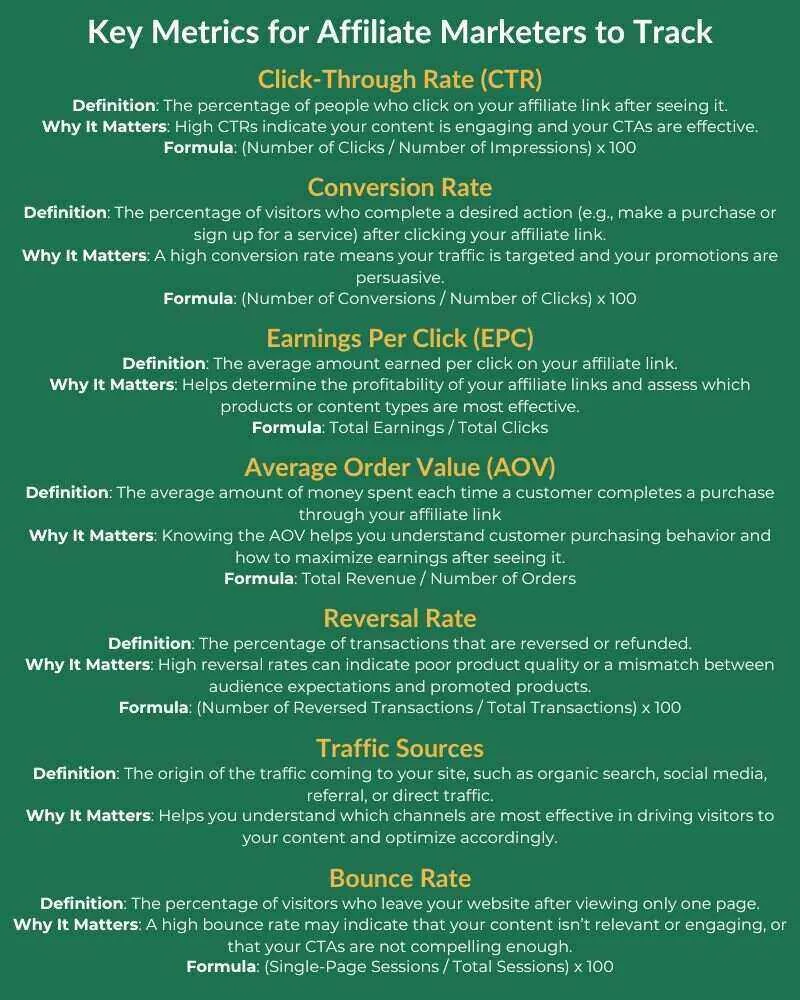
Start A/B Testing
A/B testing is when you make two versions of a webpage or element to see which performs better. You can use tools like VWO (which has a free starter plan) or basic A/B testing functionality on email marketing platforms like Mailchimp.
If you’re unfamiliar with this sort of testing, start small by comparing different headlines, CTA buttons, or promotional messages, for example. You’ll see the benefits and can use the results to drive your marketing strategy.
Adjust and Optimize
Use the insights from your data analysis to tweak and improve your strategy. For example, create more of the same if you notice a particular type of content doing well. If a product isn’t getting clicks or conversions, determine if this is because it is unsuitable for your audience or because you’ve not marketed it effectively enough. Knowing how to adapt and prosper is one of the behaviors covered in my “Ten Steps to Positivity” series, and I invite you to take a read.
Set Clear Goals: Establish specific, measurable goals for your affiliate marketing efforts. Whether it’s increasing traffic, improving conversion rates, or boosting sales, clear goals help you stay focused and track your progress effectively.
Step 9: Scale Your Business
You’ve shown sturdy signs of commitment by reading this far, and it may have dawned on you that there are no shortcuts to success with affiliate marketing. There will undoubtedly be hurdles and bumps on the road, but you don’t have to conquer everything in a day. Take one step at a time, and the process will click into place as you grow more comfortable. Then, it’s time to think about scaling your business!
After many repeats of the earlier steps, you’ll be earning regular passive income but still harboring a desire to leave your day job. Now, you need to seize every opportunity, maximize your potential, and allow your business and profits to grow.
You’ll miss some of the responsibilities you need to let others manage now, but the aim is to build a machine that oils itself and allows you to focus on the bigger picture rather than daily tasks. This involves optimizing processes and increasing your revenue, so let’s look at how to scale your affiliate marketing business when the time is right:
Diversify Your Income Streams
No matter the appeal of consistent success with a stationary model, you must eventually diversify or scale up your operation to grow a business. You can do this by researching new programs and products that complement your existing content and audience. Nothing is forever, and this reduces your risk if your current range of products stops being profitable.
When you’re ready to level up, you’re probably an expert and well-respected in your niche. You deeply understand the gaps and pain points in your market and can create your own products or services—you could even write a book! Scaling through an e-commerce store, training courses, or consulting can be profitable. Doing these things without brand recognition is possible but will be harder to promote.
Incorporate advertising services like Google AdSense on your website. AdSense allows you to earn revenue from display ads, providing extra income when your website is visited.
Ensure you’ve explored every depth of your existing niche before switching to a new one, which is another way to diversify. Exploring different markets and broadening your horizons with a new niche is possible, but it does involve starting from the ground up again. Make sure you are suitably experienced, enthusiastic, and confident before you go in this direction.
For beginners, it’s good to ponder and visualize your future expansion. Write down your ideas now, while they are still fresh, as a one-page business plan you can refer back to when ideas have long been forgotten. Start small, aim high, and dream big—and don’t lose that one-page plan!
Outsource and Automate
Time pressures come alongside business growth, so you should consider outsourcing tasks and using automation tools to streamline your processes. The day-to-day is too much for a one-person band looking to play a big arena!
Connect with freelancers through Fiverr or Upwork and outsource content creation, graphic design, social media management, and SEO tasks. Use automation tools to keep everything organized, which is crucial if you use third-party suppliers. Find the automation tools you need and use them wisely. For example, IFTTT can automate social media posts, while StoryChief is extremely useful when collaborating on projects.
Expand Your Reach
Think about how you will continue attracting more people to your website and what methods you’ll use. This might mean targeting different demographics, translating your content into other languages, or trying new marketing channels.
If platforms like TikTok or Pinterest align with your niche, test them. Or, if you haven’t already, start a YouTube channel for your business. Research and do small tests to gauge effectiveness before a full-scale launch, and think about whether this can be outsourced, too.
Invest in Education
The key to success in affiliate marketing is staying ahead of the curve, so expedite your personal growth alongside your business by investing in education. Webinars, courses, books, and affiliate marketing communities are all valuable. Niche-related learning is equally important, so apply the same approach to remain present and up to speed in your sector.
Check out my reviews of Wealthy Affiliate and SoloBuildIt!, two platforms offering comprehensive training and community support for affiliate marketing beginners. I’d be delighted to see you there!
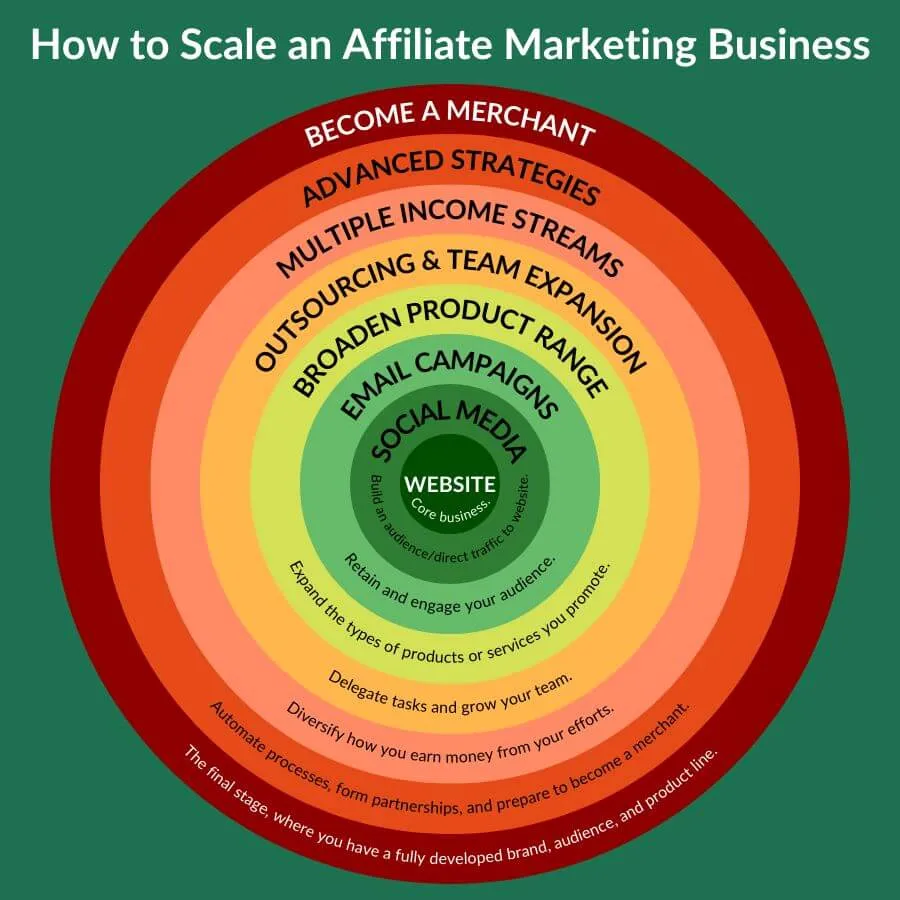
Build Partnerships: Working with other affiliate marketers, influencers, or businesses in your niche can help you tap into new audiences and increase credibility. Look for partners with similar values and start by guest blogging, co-hosting webinars, or launching joint campaigns. Collaborations are a driving force of ambition and can be essential when scaling your business.
Step 10: Stay Motivated and Overcome Challenges
It’s tough to stay motivated when creative adrenalin begins to ebb, and you realize you weren’t being hoodwinked when told affiliate marketing was a long game. Every successful marketer has been in the same doldrums, but there are strategies you can employ to stave off defeatism and avoid burnout:
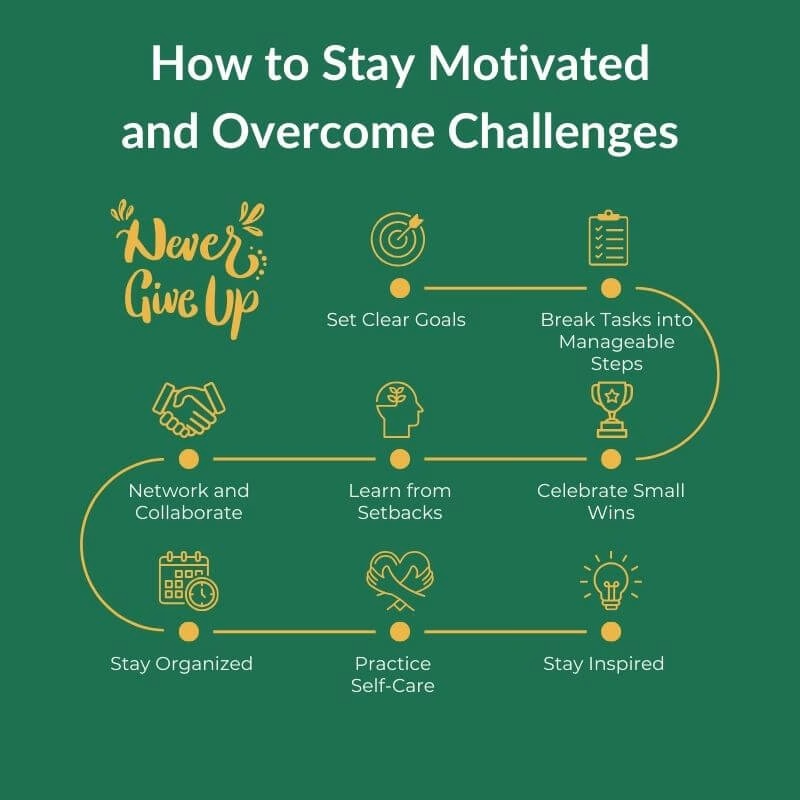
Set Realistic Goals and Celebrate Small Wins
Setting SMART goals (specific, measurable, achievable, relevant, and time-bound) will give you direction and keep you focused on what matters most. Use tools like Trello or Notion to track your progress.
- Break down your bigger goals into smaller tasks and celebrate each small win.
- Don’t set unrealistic goals without a plan. Doing so only leads to frustration and burnout when you should be focused on making progress.
Build a Support Network
Joining forums like AffiliateFix, Warrior Forum, or Facebook groups dedicated to affiliate marketing will give you encouragement and inspiration. You’re bound to find some practical advice there, too. Participating in webinars, workshops, and virtual events is a great way to connect with others in your industry. Build a network within your niche, as bouncing ideas around in a group is often more rewarding than brainstorming alone.
- Consider joining SoloBuildIt! or Wealthy Affiliate to combine learning with community.
- Don’t try to go it alone without support or mentorship. Building connections can open doors to new opportunities and insights.
Learn from Your Failures
Every mistake is an opportunity to learn and often a stepping stone to success.
- Keep a journal of what works and what doesn’t. This will help you make better decisions in the future and develop quick-win projects at will.
- Don’t dwell on failures or give up too soon. Persistence is the key to your long-term success, so remind yourself of your unbreakable resilience when you check your website’s latest data, for example.
Stay Educated and Adapt to Changes
Keeping up with the latest trends, technologies, and regulations is essential because affiliate marketing’s goalposts are always moving. Invest in learning to prevent your knowledge and experience from stagnating.
- Follow blogs like Smart Passive Income or Backlinko for tips and updates, subscribe to affiliate newsletters, and consider taking advanced courses to improve your skill set. Platforms like Udemy or Skillshare are good places to look for further education.
- Don’t persist with things that aren’t working. Instead, stay on the pulse of your business—your ability to flex will be crucial to staying competitive.
Manage Your Time and Energy
To cope with multiple tasks and responsibilities, you must find ways to manage your time effectively. Use productivity tools to schedule and prioritize tasks that will grow your business.
- Track time and maintain focus with Pomodoro Technique apps or Toggl.
- Don’t multitask, as this will dilute your efforts. Focus on one task at a time to maximize productivity.
- Don’t overload yourself with tasks without planning; this can lead to burnout.
Stay Inspired by Celebrating Your “Why”
Remind yourself regularly why you started in affiliate marketing. Whether it’s financial freedom, a flexible lifestyle, or a passion for a specific niche, keeping your “why” in mind will get you through the tough times.
- Create a vision board or use an app like MindMeister to visualize your goals and remind yourself of your purpose.
- Don’t lose sight of your original motivation, which can lead to apathy. Regularly revisit your “why” to stay inspired.
Check out my “How to Stay Invested in Affiliate Marketing Projects” post if you need more ways to boost your enthusiasm. It’s all part of the learning curve!
Reward Yourself: Rewarding yourself for hitting milestones is essential, no matter how small. Treat yourself to something you enjoy: a day off, a nice meal, or a small gift. Recognizing your achievements reinforces positive behavior and keeps you motivated. It’s not an endless journey!
Next Steps: Learn the Behaviors of Successful Marketers
Go to my “Ten Steps to Positivity” series to explore the behaviors of successful affiliate marketers. It’s packed with actionable advice, tips, and examples that add to the techniques I’ve identified in this post. It all starts with being patient, of course:
Remember, anyone can start affiliate marketing, even with no prior experience. It’s about starting small and growing at your own pace. You don’t need to worry about inventory or customer service hassles. This model allows you to hone valuable marketing and business skills while pursuing financial independence.
Ultimately, affiliate marketing empowers you to become a self-starter and take control of your future. It’s an opportunity to gain confidence, achieve personal fulfillment, and connect with a supportive community.
Now that you know how affiliate marketing works, it’s time to take action. Choose a niche, find affiliate programs, build your online presence, create engaging content, and start promoting. You’ve got this!



